Site Menu:
| This is an archived Horseadvice.com Discussion. The parent article and menus are available on the navigation menu below: |
| HorseAdvice.com » Diseases of Horses » Endocrine System » Pituitary Pars Intermedia Dysfunction (PPID): Equine Cushing's » |
| Discussion on Cushings in an easy keeper? | |
| Author | Message |
| Member: Mwebster |
Posted on Wednesday, Aug 23, 2006 - 9:28 pm: Dear DrO,My husband's 28 yr old, 16.3h Morgan has a couple possible Cushings symptoms, but then some contradictory signs. He gets an extremely heavy coat, about 4" long, in the winter, and then doesn't shed out very quickly anymore in the spring, so we've been clipping to keep him comfortable. But the coat isn't wavy or coarse, it doesn't have that Cushing's look about it -- it's soft and silky, nice and shiny. And he sheds a ton, just not enough. He has some of the fat pockets and the crest we associate with Cushings, but then he's also an easy keeper, in very good flesh. He's always had some fat and some crest. He's on grass and hay, no grain at all. No excessive drinking/urination, and we know exactly how much he drinks, as he's got his own large grass paddock (note, not super-lush grass, and they're all on it year round 7x24). In fact, he drinks a bucket less per day than the other 2 horses, who are 9 and 12. Appetite is great. Attitude is good, though he has been a little less eager to go out on hacks the last couple of years. But we had chalked that up to some lameness issues, as he has some ringbone, and also a stifle thing (just had that injected). He's always had great feet, nice and big, but: our farrier noted that his white line is striated -- sort of looks like little black etched lines -- on all 4 feet, though a little more pronounced in the front. Our farrier says this is laminar stretching, essentially mild laminitis, and that this is often one of the first things he sees in a mildly Cushinoid horse. Note, we changed farriers recently, the former farrier never said anything, so we don't know how long his white lines have looked this way. A resting ACTH was at the very top of the normal range (back in June). At that time, our vet thought we should keep an eye on it, but wait to treat. We're considering starting him on pergolide, we certainly don't want to see laminitis brewing. There isn't anything on your management list we don't already do as a matter of course. Does this case sound like a likely Cushings situation, and do you see this sort of striated white line as a Cushings symptom? Does it make sense to start pergolide right away? If it weren't for the concern about how his white line looks, we probably would have waited on the pergolide, as the horse is otherwise in great health. Thanks for any suggestions. |
| Moderator: DrO |
Posted on Thursday, Aug 24, 2006 - 6:21 am: Hello Melissa,Your horse has early signs but I think, like most Morgans I see, that the horse displays signs of Metabolic SynDrOme (also on the Endocrine Disease menu page) also. 20 years ago we just called him an "easy keeper". Folks use to confuse the two but they are really different entities that share some endocrine (insulin resistance) and clinical features (founder). All white lines are striated so I am uncertain what you see is abnormal and if it is there are most likely several possible causes. I don't know any reason that someone could predict Cushings is coming from any change down there. I think he is confusing your horse with horses that have had laminitis episodes associated with their early onset of Cushings. I don't believe in "pretreating" for the disease or chasing lab results with medication, many horses don't founder. You treat when you get significant clinical signs that cannot be managed. Fortunately most onsets of uncomplicated founder begin slowly and mildly. You should however be managing your horses condition and nutrition to minimize the chance of founder. Both the article on Cushings and Founder overview have many suggestions. DrO |
| Member: Jojo15 |
Posted on Thursday, Aug 24, 2006 - 7:49 am: So glad to hear you're not feeding grain. My 24 year old has been taken off grain almost a year ago, and she is none the worse for wear over it. Same issues. too fat. cresty neck. hoof changes. And our acth was up in one test and normal in another. She is sitting on that fence too. Same with the feet. I do trim religiously every 4 weeks. And just these two practices have helped keep anything weird at bay. I added minerals, and worm a bit more religiously. This summer i saw her shed out. And get a her pretty summer shine. Maybe it just takes a bit. Or maybe she is on too lush a grass. Ever consider a grazing muzzle? |
| Member: Mwebster |
Posted on Thursday, Aug 24, 2006 - 1:04 pm: Hi DrO,Thanks very much for your reply. Yes, the white line is striated, but you have to bend down to see that, and on our other horses it's still a uniform cream color. With Rebel, it looks like someone has taken a fine black pen and drawn tiny thin lines, and you don't need to bend down to see that. Pretty obvious. I'm not sure why there would be dark lines unless dirt s getting up into the laminae, but that doesn't make any sense, as the farrier took off some toe and it's still there in the (newly exposed) white lines. Yes, I agree the horse could have the ED you are mentioning. I'll re-read the artcle. So, if this finding isn't significant, then we could postpone treating. This was our specific concern: was this white line appearance in fact a sign of "founder beginning slowly and mildly". We would feel awful if we caught it too late and put this wonderful horse through a bout of laminitis. So my takeaway is: you don't think this white line appearance is a meaningful clinical sign. Thanks for the guidance. Jojo, thanks for your input. He's not fat -- he's actually a good weight. The grass is short, we don't fertilize and it's not lush, and he's lived on the same grass for the last 8 years. He actually prefers last year's (plain timothy) hay to the grass, so we know it's not that exciting. He's in/out 7x24, and it keeps him walking around, nibbling, content, and fitter than if he were in a dirt paddock eating hay, standing in one place. So I'd hate to change that around, and anyhow we don't have any dirt paddocks. Melissa |
| Moderator: DrO |
Posted on Thursday, Aug 24, 2006 - 4:51 pm: Not being able to examine the white line I don't want to say it might not be significant, I just knew striations were not out of the range of normal and staining may make them look dark. If you have black areas invading the white line, you are getting dirt and usually tiny focal areas of thrush in these areas which would be a mild form of seedy toe, see Diseases of Horses » Lameness » Diseases of the Hoof » Thrush for treatment and prevention of this condition.The fact you are getting mild seedy toe may be significant and most often from a toe left too long. The increase stress at the toe both from being to stretched from the increase in diameter as the toe grows out and during breakover the laminae separate. But you diagnose this by looking at the foot balance. DrO |
| Member: Mwebster |
Posted on Thursday, Aug 24, 2006 - 6:19 pm: Dear DrO,That's a very interesting idea, I will read up on seedy toe. Thank you very much! The farrier we replaced was definitely not getting the balance right (broken back a little, and low on the inside), and we used to go 6 weeks between shoeing. So perhaps that contributed to seedy toe, though the A/P balance wasn't as big an issue as the M/L. But the new farrier has been doing him for 3 months now... and put him in what he calls "accelerated breakover shoes" -- which are normal shoes that he puts a very slight belly into. If you didn't know the shoe wasn't flat, you'd never notice. I can post a picture (this is a farrier who comes from the Redden school, though our horses aren't in therapeutic shoes). And so the fact that it's not superficial, i.e. doesn't trim off, and he had it last shoeing 5 weeks ago too, would suggest that either it's an ongoing problem or we're dealing with something that went pretty deep (but might be growing out)? Sounds like it would be the former? i.e. seedy toe won't go away on its own, just by improving the shoeing? And I read the post about "Thrush in white line", with the picture of what one HA member said was white line disease. That's (unfortunately) what Rebel's white line looks like -- that black/white striated look. And the WL is also widened. So is seedy toe the same as WLD? Thanks again! Melissa |
| Moderator: DrO |
Posted on Thursday, Aug 24, 2006 - 9:05 pm: I would be interested in seeing the foot and shoe and as you might guess we have an article on white line disease, see Diseases of Horses » Lameness » Diseases of the Hoof » White Line Disease or Onchyomycosis.DrO |
| Member: Erika |
Posted on Thursday, Aug 24, 2006 - 10:33 pm: Yeah, pictures, please. Got another odd white line case. |
| Member: Mwebster |
Posted on Monday, Aug 28, 2006 - 8:09 pm: Dear DrO,I'll take pix tomorrow and post. Concept is that landing on a totally flat foot makes breakover difficult, this is how this farrier shoes for healthy feet (not merely a therapeutic approach). And he says it's also good for horses with heel issues, as it is an alternative to the wedge or eggbar approach (which can crush them), although Rebel has wedges right now in the front, which he hopes to eliminate in another shoeing or two (testimony to how awry his feet had gone, with the prior farrier, as he has been happily barefoot in the past). Our new farrier shod our new horse this week (for the first time), and I'm quite surprised at the change: the horse stands with his feet much more under him (he's a big horse, and long), and he hasn't tripped once since (he tripped a few times every ride before). We've had the horse for a month, and he was shod the week before we got him, and his M/L balance was perfect (per xrays) and his A/P was 166 degrees, so pretty good -- i.e. we weren't dealing with an unbalanced foot. So, back to Rebel... I wish I could also post a picture of what the unshod but trimmed foot looks like, so you could see the white line, etc. It's wider than normal, and those little black lines... I was just thinking how this can't be a simple case of seedy toe or WLD, because it's the same in all 4 feet, all the way around each white line! We've never had a case of seedy toe before, or WLD, and the only time we've had thrush was when a horse arrived with it. So the more I think about it, it seems unlikely. Or if it is, it would have to be something systemic affecting all 4 feet. On the soundness front: Rebel is a new horse post-stifle injection. He is moving with real spring, and happy to go out, offering up canters. So the stifle injection was right on. I hope he's lucky and it lasts more than 6 months between injections! Our primary care DVM came today to give the horses an EEE and WNV booster (we're in MA, recent outbreaks of both), and gave us a bottle of pergolide for Rebel. We'll put him on that and see if we see additional improvements (shedding out, even brighter attitude, etc. -- and maybe foot changes). If not, we'll discontinue. I know lots of other folks around us with aged horses that are on it, so no problem giving away unused meds! Pix tomorrow. Best, Melissa |
| Member: Mwebster |
Posted on Saturday, Sep 2, 2006 - 7:52 pm: As promised, pix.First one is of the new horse, who has great feet, in the "enhanced breakover shoes", i.e. normal shoes into which the farrier puts a little "belly". Here's a picture of Rebel's front left and a view of the sole Here's his hind left and a closeup And here is the venerable Rebel himself |
| Member: Mwebster |
Posted on Saturday, Sep 2, 2006 - 7:54 pm: Hm... I got an error about one or more of my images being too big. What's the max size per image, maybe I can figure out how to save them with lower resolution...Thanks, Melissa |
| Moderator: DrO |
Posted on Sunday, Sep 3, 2006 - 8:45 am: Melissa, go to the HELP topic and you will find a topic on posting requirements and links to programs that allow you to adjust the file size and the image size.DrO |
| Member: Mwebster |
Posted on Sunday, Sep 3, 2006 - 12:07 pm: Thanks, these should be OK: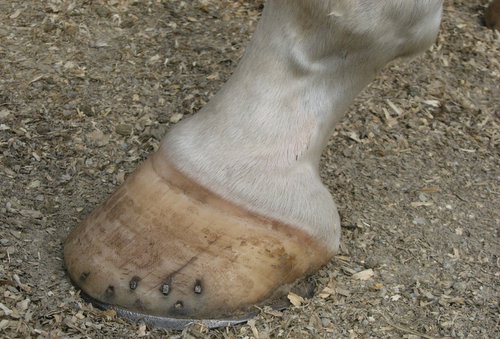 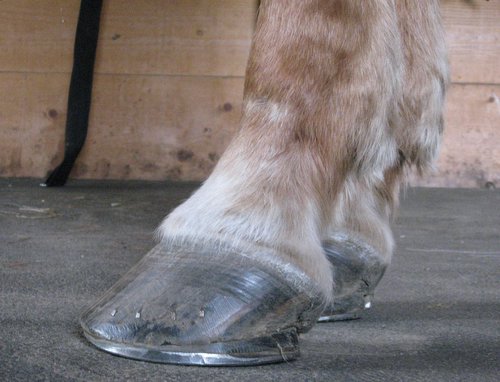 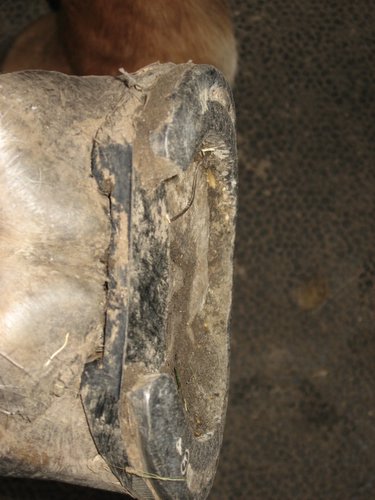 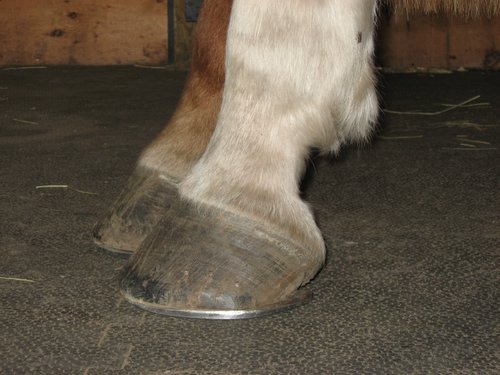 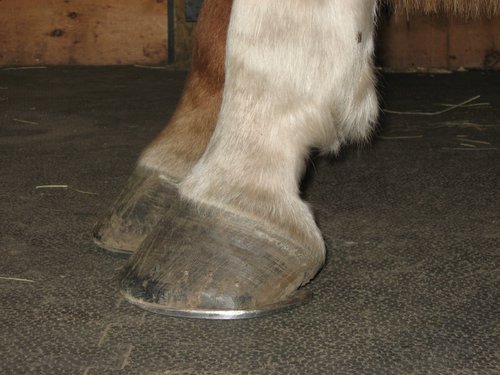 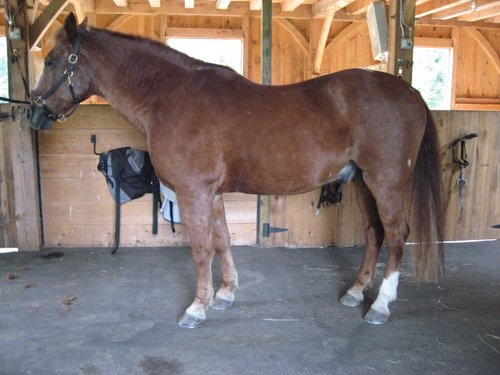
|
| Member: Mwebster |
Posted on Sunday, Sep 3, 2006 - 12:11 pm: Here's one more of Rebel's front left, as I realized you can't really see the shoe isn't flat in the other pix...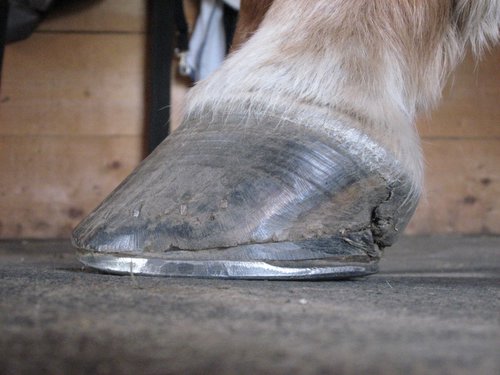
|
| Moderator: DrO |
Posted on Tuesday, Sep 5, 2006 - 7:18 am: Melissa,I count five feet in the above pictures, but it appears the white at the top a mistake so I will ignore it. The Morgan's fronts have a long toe, run under heel conformation. I would also guess the soles are thin for such a large horse and prevent correcting the a-p imbalance in a single trimming. If there are white line changes they are most likely caused by the shearing forces of such conformation, and not founder. I suggest lateral radiographs to position the toe bone in the hoof wall but have managed these by just trimming. I see the attempts to correct the conformation with a 3 degree bar pad, setting the shoe back and rockering the toe, all which I agree with. But in my opinion the toe is still being left too long in front and the heels do not appear to be adequately supported on the outside and behind. I would square the toe which may mean taking the toe wall back close to the white line, and maybe be a bit more aggressive with the rocker. A New Balance shoe in combination with the bar wedge works well in my hands for this. These decrease the shearing forces and stimulates the wall at the heel to grow stronger and more upright. I would also like to see this horses hoof care program reviewed starting at Care for Horses » Hoof Care » Care of the Hoof: an Overview. DrO |
| Member: Mwebster |
Posted on Friday, Sep 15, 2006 - 10:01 pm: Dear DrO,Thanks so much for your reply. Yes, the first picture was the front foot of a different horse, I posted for reference to show what this farrier does (with curved shoes) on a horse without issues. Re our Morgan, I confess I was very struck by what the pix at ground level revealed. The toes don't look as long from human eye level as they do in the photos, where I put the camera right on the aisle floor. I agree, the toes look too long. From this horse's radiographs, we know that his coffin bones don't line up with anterior surface of the hoof wall, but this farrier hasn't really reviewed them, so I think the long toe is more of a mistake than a deliberate correction to coincide with the angle in the radiographs. The coffin bones (per xrays) are definitely pointing at a steeper angle, i.e. there is more wall (greater depth between front of hoof wall and coffin bone) at the bottom of the hoof than further up the hoof wall. I think the lines on the hoof wall in the upper 1/3rd coincide with starting to use this farrier. I am a little troubled by the growth being an arc. Is this a process to recover from what the prior farrier did, or are we seeing a strange growth pattern that shows the hoof responding to a new set of stresses that aren't necessarily a balanced set of stresses? It doesn't seem to me that an arc is a healthy shape. In particular, the quarters seem to lift, then the heel DrOps. What does that mean, in terms of how the foot is growing? Thanks again, Melissa |
| Moderator: DrO |
Posted on Sunday, Sep 17, 2006 - 7:08 pm: The arc is a result of the past long toe underrun heel conformation that is likely to be do to past trimming problems in my opinion. I think it can be improved in time with proper trimming.DrO |
| Member: Mwebster |
Posted on Monday, Sep 18, 2006 - 9:32 pm: Thanks, DrO, for your reply. That's comforting. We'll see what those front feet look like in a few months. The fact that he already stands much more upright seems to indicate he appreciates the better balance. Sure wish we'd changed farriers sooner. We let the new farrier know we thought the toes were still a little long. I'll photograph in the AM, he was reshod today.Best, Melissa |
is The Horseman's Advisor
Helping Thousands of Equestrians, Farriers, and Veterinarians Every Day
All rights reserved, © 1997 -
